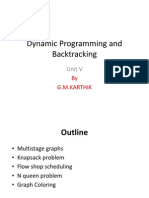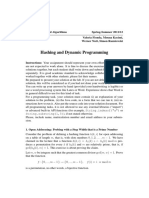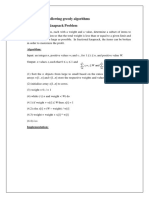Introduction To Algorithms Second Edition By: Cormen, Leiserson, Rivest & Stein
Uploaded by
Tushar ChauhanIntroduction To Algorithms Second Edition By: Cormen, Leiserson, Rivest & Stein
Uploaded by
Tushar ChauhanIntroduction to Algorithms
Second Edition
by
Cormen, Leiserson, Rivest & Stein
Chapter 15
Assembly Line Scheduling
Problem
the fastest way through station S1,j-1 and then directly through
station S1,j, or
the fastest way through station S2,j-1, a transfer from line 2 to
line 1, and then through station S1,j.
the fastest way through station S2,j-1 and then directly through
station S2,j, or
the fastest way through station S1,j-1, a transfer from line 1 to
line 2, and then through station S2,j.
Step 1: The structure of the fastest way through the factory
the fastest way through station S1,j is either
the fastest way through station S2,j is either
Step 2: A recursive solution
Step 3: Computing the fastest times
PRINT-STATIONS (l, n)
Copyright The McGraw-Hill Companies, Inc. Permission required for reproduction or display.
Copyright The McGraw-Hill Companies, Inc. Permission required for reproduction or display.
Matrix Chain Multiplication
Problem
Copyright The McGraw-Hill Companies, Inc. Permission required for reproduction or display.
Copyright The McGraw-Hill Companies, Inc. Permission required for reproduction or display.
Step 1: The structure of an optimal parenthesization
let us adopt the notation A
ij
, where i j, for the matrix that results
from evaluating the product A
i
A
i+1
A
j
.
Ifthe problem is nontrivial, i.e., i < j, then any parenthesization of the
product A
i
A
i+1
A
j
must split the product between A
k
and A
k+1
for some
integer k in the range i k < j. That is, for some value of k, we first
compute the matrices A
ik
and A
k+1j
and then multiply them together to
produce the final product A
ij
.
The cost of this parenthesization is thus the cost of computing the
matrix A
ik
, plus the cost of computing A
k+1j
, plus the cost of
multiplying them together.
Copyright The McGraw-Hill Companies, Inc. Permission required for reproduction or display.
Step 2: A recursive solution
Copyright The McGraw-Hill Companies, Inc. Permission required for reproduction or display.
Step 3: Computing the optimal costs
Copyright The McGraw-Hill Companies, Inc. Permission required for reproduction or display.
Copyright The McGraw-Hill Companies, Inc. Permission required for reproduction or display.
Copyright The McGraw-Hill Companies, Inc. Permission required for reproduction or display.
Copyright The McGraw-Hill Companies, Inc. Permission required for reproduction or display.
Copyright The McGraw-Hill Companies, Inc. Permission required for reproduction or display.
Longest Common Subsequence
Problem
Copyright The McGraw-Hill Companies, Inc. Permission required for reproduction or display.
Copyright The McGraw-Hill Companies, Inc. Permission required for reproduction or display.
0 if i=0, or j=0
c[i,j] = c[i-1,j-1]+1 if i, j>0 and x
i
= y
j,
max{c[i-1,j], c[i,j-1]} if i, j>0 and x
i
= y
j,
Copyright The McGraw-Hill Companies, Inc. Permission required for reproduction or display.
Copyright The McGraw-Hill Companies, Inc. Permission required for reproduction or display.
Copyright The McGraw-Hill Companies, Inc. Permission required for reproduction or display.
Optimal Binary Search Tree
Problem
Copyright The McGraw-Hill Companies, Inc. Permission required for reproduction or display.
Copyright The McGraw-Hill Companies, Inc. Permission required for reproduction or display.
Copyright The McGraw-Hill Companies, Inc. Permission required for reproduction or display.
Copyright The McGraw-Hill Companies, Inc. Permission required for reproduction or display.
All Pair Shortest Path
The structure of a shortest path
For the all-pairs shortest-paths problem on a graph G = (V, E), all
subpaths of a shortest path should also be shortest paths.
Suppose that the graph is represented by an adjacency matrix W =
(w
ij
). Consider a shortest path p from vertex i to vertex j, and
suppose that p contains at most m edges.
Assuming that there are no negative-weight cycles, m is finite. If i =
j, then p has weight 0 and no edges.
If vertices i and j are distinct, then we decompose path p into ,
where path p now contains at most m - 1 edges.
p is a shortest path from i to k, and so (i, j) = (i, k) + w
kj
.
A recursive solution to the all-pairs shortest-paths problem
The latter equality follows since w
jj
= 0 for all j
Computing the shortest-path weights bottom up
0/1 Knapsack Problem
Given a knapsack with maximum capacity W, and a set S
consisting of n items.
Each item i has some weight w
i
and benefit value b
i
(all w
i
, b
i
and W are integer values)
Problem: How to pack the knapsack to achieve maximum
total value of packed items?
0-1 Knapsack problem
W = 20
w
i
b
i
10 9
8
5
5
4
4
3
3
2
Items
This is a knapsack
Max weight: W = 20
0-1 Knapsack problem:
e e
s
T i
i
T i
i
W w b subject to max
Problem, in other words, is to find
The problem is called a 0-1 problem, because each item
must be entirely accepted or rejected.
Just another version of this problem is the Fractional
Knapsack Problem, where we can take fractions of items.
Defining a Subproblem
If items are labeled 1..n, then a subproblem would be to find an
optimal solution for S
k
= {items labeled 1, 2, .. k}
Recursive Formula for subproblems
+
>
=
else } ] , 1 [ ], , 1 [ max{
if ] , 1 [
] , [
k k
k
b w w k B w k B
w w w k B
w k B
It means, that the best subset of S
k
that has total weight w is one
of the two:
1) the best subset of S
k-1
that has total weight w, or
2) the best subset of S
k-1
that has total weight w-w
k
plus the item k
The best subset of S
k
that has the total weight w,
either contains item k or not.
First case: w
k
>w. Item k cant be part of the
solution, since if it was, the total weight would be
> w, which is unacceptable
Second case: w
k
<=w. Then the item k can be in
the solution, and we choose the case with greater
value
0-1 Knapsack Algorithm
for w = 0 to W
B[0,w] = 0
for i = 0 to n
B[i,0] = 0
for w = 0 to W
if w
i
<= w // item i can be part of the solution
if b
i
+ B[i-1,w-w
i
] > B[i-1,w]
B[i,w] = b
i
+ B[i-1,w- w
i
]
else
B[i,w] = B[i-1,w]
else B[i,w] = B[i-1,w] // w
i
> w
Example:
n = 4 (Number of elements)
W = 5 (max weight)
Elements (weight, benefit):
(2,3), (3,4), (4,5), (5,6)
11/28/2013 45
Example (2)
for w = 0 to W
B[0,w] = 0
0
0
0
0
0
0
W
0
1
2
3
4
5
i
0 1 2 3
4
11/28/2013 46
Example (3)
for i = 0 to n
B[i,0] = 0
0
0
0
0
0
0
W
0
1
2
3
4
5
i
0 1 2 3
0 0 0 0
4
11/28/2013 47
Example (4)
if w
i
<= w // item i can be part of the solution
if b
i
+ B[i-1,w-w
i
] > B[i-1,w]
B[i,w] = b
i
+ B[i-1,w- w
i
]
else
B[i,w] = B[i-1,w]
else B[i,w] = B[i-1,w] // w
i
> w
0
0
0
0
0
0
W
0
1
2
3
4
5
i
0 1 2 3
0 0 0 0
i=1
b
i
=3
w
i
=2
w=1
w-w
i
=-1
Items:
1: (2,3)
2: (3,4)
3: (4,5)
4: (5,6)
4
0
11/28/2013 48
Example (5)
if w
i
<= w // item i can be part of the solution
if b
i
+ B[i-1,w-w
i
] > B[i-1,w]
B[i,w] = b
i
+ B[i-1,w- w
i
]
else
B[i,w] = B[i-1,w]
else B[i,w] = B[i-1,w] // w
i
> w
0
0
0
0
0
0
W
0
1
2
3
4
5
i
0 1 2 3
0 0 0 0
i=1
b
i
=3
w
i
=2
w=2
w-w
i
=0
Items:
1: (2,3)
2: (3,4)
3: (4,5)
4: (5,6)
4
0
3
11/28/2013 49
Example (6)
if w
i
<= w // item i can be part of the solution
if b
i
+ B[i-1,w-w
i
] > B[i-1,w]
B[i,w] = b
i
+ B[i-1,w- w
i
]
else
B[i,w] = B[i-1,w]
else B[i,w] = B[i-1,w] // w
i
> w
0
0
0
0
0
0
W
0
1
2
3
4
5
i
0 1 2 3
0 0 0 0
i=1
b
i
=3
w
i
=2
w=3
w-w
i
=1
Items:
1: (2,3)
2: (3,4)
3: (4,5)
4: (5,6)
4
0
3
3
11/28/2013 50
Example (7)
if w
i
<= w // item i can be part of the solution
if b
i
+ B[i-1,w-w
i
] > B[i-1,w]
B[i,w] = b
i
+ B[i-1,w- w
i
]
else
B[i,w] = B[i-1,w]
else B[i,w] = B[i-1,w] // w
i
> w
0
0
0
0
0
0
W
0
1
2
3
4
5
i
0 1 2 3
0 0 0 0
i=1
b
i
=3
w
i
=2
w=4
w-w
i
=2
Items:
1: (2,3)
2: (3,4)
3: (4,5)
4: (5,6)
4
0
3
3
3
11/28/2013 51
Example (8)
if w
i
<= w // item i can be part of the solution
if b
i
+ B[i-1,w-w
i
] > B[i-1,w]
B[i,w] = b
i
+ B[i-1,w- w
i
]
else
B[i,w] = B[i-1,w]
else B[i,w] = B[i-1,w] // w
i
> w
0
0
0
0
0
0
W
0
1
2
3
4
5
i
0 1 2 3
0 0 0 0
i=1
b
i
=3
w
i
=2
w=5
w-w
i
=2
Items:
1: (2,3)
2: (3,4)
3: (4,5)
4: (5,6)
4
0
3
3
3
3
11/28/2013 52
Example (9)
if w
i
<= w // item i can be part of the solution
if b
i
+ B[i-1,w-w
i
] > B[i-1,w]
B[i,w] = b
i
+ B[i-1,w- w
i
]
else
B[i,w] = B[i-1,w]
else B[i,w] = B[i-1,w] // w
i
> w
0
0
0
0
0
0
W
0
1
2
3
4
5
i
0 1 2 3
0 0 0 0
i=2
b
i
=4
w
i
=3
w=1
w-w
i
=-2
Items:
1: (2,3)
2: (3,4)
3: (4,5)
4: (5,6)
4
0
3
3
3
3
0
11/28/2013 53
Example (10)
if w
i
<= w // item i can be part of the solution
if b
i
+ B[i-1,w-w
i
] > B[i-1,w]
B[i,w] = b
i
+ B[i-1,w- w
i
]
else
B[i,w] = B[i-1,w]
else B[i,w] = B[i-1,w] // w
i
> w
0
0
0
0
0
0
W
0
1
2
3
4
5
i
0 1 2 3
0 0 0 0
i=2
b
i
=4
w
i
=3
w=2
w-w
i
=-1
Items:
1: (2,3)
2: (3,4)
3: (4,5)
4: (5,6)
4
0
3
3
3
3
0
3
11/28/2013 54
Example (11)
if w
i
<= w // item i can be part of the solution
if b
i
+ B[i-1,w-w
i
] > B[i-1,w]
B[i,w] = b
i
+ B[i-1,w- w
i
]
else
B[i,w] = B[i-1,w]
else B[i,w] = B[i-1,w] // w
i
> w
0
0
0
0
0
0
W
0
1
2
3
4
5
i
0 1 2 3
0 0 0 0
i=2
b
i
=4
w
i
=3
w=3
w-w
i
=0
Items:
1: (2,3)
2: (3,4)
3: (4,5)
4: (5,6)
4
0
3
3
3
3
0
3
4
11/28/2013 55
Example (12)
if w
i
<= w // item i can be part of the solution
if b
i
+ B[i-1,w-w
i
] > B[i-1,w]
B[i,w] = b
i
+ B[i-1,w- w
i
]
else
B[i,w] = B[i-1,w]
else B[i,w] = B[i-1,w] // w
i
> w
0
0
0
0
0
0
W
0
1
2
3
4
5
i
0 1 2 3
0 0 0 0
i=2
b
i
=4
w
i
=3
w=4
w-w
i
=1
Items:
1: (2,3)
2: (3,4)
3: (4,5)
4: (5,6)
4
0
3
3
3
3
0
3
4
4
11/28/2013 56
Example (13)
if w
i
<= w // item i can be part of the solution
if b
i
+ B[i-1,w-w
i
] > B[i-1,w]
B[i,w] = b
i
+ B[i-1,w- w
i
]
else
B[i,w] = B[i-1,w]
else B[i,w] = B[i-1,w] // w
i
> w
0
0
0
0
0
0
W
0
1
2
3
4
5
i
0 1 2 3
0 0 0 0
i=2
b
i
=4
w
i
=3
w=5
w-w
i
=2
Items:
1: (2,3)
2: (3,4)
3: (4,5)
4: (5,6)
4
0
3
3
3
3
0
3
4
4
7
11/28/2013 57
Example (14)
if w
i
<= w // item i can be part of the solution
if b
i
+ B[i-1,w-w
i
] > B[i-1,w]
B[i,w] = b
i
+ B[i-1,w- w
i
]
else
B[i,w] = B[i-1,w]
else B[i,w] = B[i-1,w] // w
i
> w
0
0
0
0
0
0
W
0
1
2
3
4
5
i
0 1 2 3
0 0 0 0
i=3
b
i
=5
w
i
=4
w=1..3
Items:
1: (2,3)
2: (3,4)
3: (4,5)
4: (5,6)
4
0
3
3
3
3
0 0
3
4
4
7
0
3
4
11/28/2013 58
Example (15)
if w
i
<= w // item i can be part of the solution
if b
i
+ B[i-1,w-w
i
] > B[i-1,w]
B[i,w] = b
i
+ B[i-1,w- w
i
]
else
B[i,w] = B[i-1,w]
else B[i,w] = B[i-1,w] // w
i
> w
0
0
0
0
0
0
W
0
1
2
3
4
5
i
0 1 2 3
0 0 0 0
i=3
b
i
=5
w
i
=4
w=4
w- w
i
=0
Items:
1: (2,3)
2: (3,4)
3: (4,5)
4: (5,6)
4
0 0 0
3
4
4
7
0
3
4
5
3
3
3
3
11/28/2013 59
Example (15)
if w
i
<= w // item i can be part of the solution
if b
i
+ B[i-1,w-w
i
] > B[i-1,w]
B[i,w] = b
i
+ B[i-1,w- w
i
]
else
B[i,w] = B[i-1,w]
else B[i,w] = B[i-1,w] // w
i
> w
0
0
0
0
0
0
W
0
1
2
3
4
5
i
0 1 2 3
0 0 0 0
i=3
b
i
=5
w
i
=4
w=5
w- w
i
=1
Items:
1: (2,3)
2: (3,4)
3: (4,5)
4: (5,6)
4
0 0 0
3
4
4
7
0
3
4
5
7
3
3
3
3
11/28/2013 60
Example (16)
if w
i
<= w // item i can be part of the solution
if b
i
+ B[i-1,w-w
i
] > B[i-1,w]
B[i,w] = b
i
+ B[i-1,w- w
i
]
else
B[i,w] = B[i-1,w]
else B[i,w] = B[i-1,w] // w
i
> w
0
0
0
0
0
0
W
0
1
2
3
4
5
i
0 1 2 3
0 0 0 0
i=4
b
i
=5
w
i
=4
w=1..4
Items:
1: (2,3)
2: (3,4)
3: (4,5)
4: (5,6)
4
0 0 0
3
4
4
7
0
3
4
5
7
0
3
4
5
3
3
3
3
11/28/2013 61
Example (17)
if w
i
<= w // item i can be part of the solution
if b
i
+ B[i-1,w-w
i
] > B[i-1,w]
B[i,w] = b
i
+ B[i-1,w- w
i
]
else
B[i,w] = B[i-1,w]
else B[i,w] = B[i-1,w] // w
i
> w
0
0
0
0
0
0
W
0
1
2
3
4
5
i
0 1 2 3
0 0 0 0
i=4
b
i
=5
w
i
=4
w=5
Items:
1: (2,3)
2: (3,4)
3: (4,5)
4: (5,6)
4
0 0 0
3
4
4
7
0
3
4
5
7
0
3
4
5
7
3
3
3
3
You might also like
- A Detailed Lesson Plan in Grade 7 Mathematics0% (1)A Detailed Lesson Plan in Grade 7 Mathematics5 pages
- 0-1 Knapsack Using Dynamic Programming: Made ByNo ratings yet0-1 Knapsack Using Dynamic Programming: Made By43 pages
- Prepared By: Bushra Tufail Presented To: Miss Sadaf YasmeenNo ratings yetPrepared By: Bushra Tufail Presented To: Miss Sadaf Yasmeen41 pages
- Prepared By: Bushra Tufail Presented To: Miss Sadaf YasmeenNo ratings yetPrepared By: Bushra Tufail Presented To: Miss Sadaf Yasmeen41 pages
- Prepared By: Bushra Tufail Presented To: Miss Sadaf YasmeenNo ratings yetPrepared By: Bushra Tufail Presented To: Miss Sadaf Yasmeen41 pages
- WINSEM2024-25_BCSE204L_TH_VL2024250501496_2025-01-08_Reference-Material-INo ratings yetWINSEM2024-25_BCSE204L_TH_VL2024250501496_2025-01-08_Reference-Material-I16 pages
- Unit 3 - Analysis and Design of Algorithm - WWW - Rgpvnotes.inNo ratings yetUnit 3 - Analysis and Design of Algorithm - WWW - Rgpvnotes.in11 pages
- DR B.C. Roy Engineering College, Durgapur: "Affiliated To MAKAUT"No ratings yetDR B.C. Roy Engineering College, Durgapur: "Affiliated To MAKAUT"23 pages
- IP Formulation Guide (Abbreviated) 15.053 and 15.058 Spring 2013No ratings yetIP Formulation Guide (Abbreviated) 15.053 and 15.058 Spring 20135 pages
- Advanced Topics in Inequalities - Franklyn Wang Et Al. - AoPS 2015 PDFNo ratings yetAdvanced Topics in Inequalities - Franklyn Wang Et Al. - AoPS 2015 PDF13 pages
- ADA Practicals - Greedy, Dynamic, GraphNo ratings yetADA Practicals - Greedy, Dynamic, Graph11 pages
- Algorithms: Dynamic Programming: 0-1 Knapsack ProblemNo ratings yetAlgorithms: Dynamic Programming: 0-1 Knapsack Problem13 pages
- Duality Theory: Z Is The Scalar Criterion ValueNo ratings yetDuality Theory: Z Is The Scalar Criterion Value8 pages
- Student's Solutions Manual and Supplementary Materials for Econometric Analysis of Cross Section and Panel Data, second editionFrom EverandStudent's Solutions Manual and Supplementary Materials for Econometric Analysis of Cross Section and Panel Data, second editionNo ratings yet
- Student Solutions Manual to Accompany Loss Models: From Data to Decisions, Fourth EditionFrom EverandStudent Solutions Manual to Accompany Loss Models: From Data to Decisions, Fourth Edition4/5 (1)
- Summer Training File at Sona Koyo Steering Systems LTDNo ratings yetSummer Training File at Sona Koyo Steering Systems LTD76 pages
- CPS 216: Advanced Database Systems: Shivnath BabuNo ratings yetCPS 216: Advanced Database Systems: Shivnath Babu23 pages
- PSET-1: So How Would One Select The Right Candidate From A Big Pool Within The Given Time-Slot?No ratings yetPSET-1: So How Would One Select The Right Candidate From A Big Pool Within The Given Time-Slot?6 pages
- Week 4: Linear Programming Modeling Quiz: Your Email Will Be Recorded When You Submit This FormNo ratings yetWeek 4: Linear Programming Modeling Quiz: Your Email Will Be Recorded When You Submit This Form4 pages
- Algorithm Design & Analysis Presentation - E-60thNo ratings yetAlgorithm Design & Analysis Presentation - E-60th18 pages
- Bairstow Method: Group 5: Fuad Nurtsani (061) Azriel IqbalNo ratings yetBairstow Method: Group 5: Fuad Nurtsani (061) Azriel Iqbal15 pages
- Lecture Note (10) Curve-Fitting Least-Squares RegressionNo ratings yetLecture Note (10) Curve-Fitting Least-Squares Regression19 pages
- Application of Linear Programming For Solving Fuzzy Transportation ProblemsNo ratings yetApplication of Linear Programming For Solving Fuzzy Transportation Problems16 pages
- Pathfinding and Graph Search AlgorithmsNo ratings yetPathfinding and Graph Search Algorithms15 pages
- Chapter 3:game Theory: 3.1optimal Decision in GamesNo ratings yetChapter 3:game Theory: 3.1optimal Decision in Games17 pages
- Data Mining Unit 3 Cluster Analysis: Types of ClustersNo ratings yetData Mining Unit 3 Cluster Analysis: Types of Clusters11 pages
- COMP219: Artificial Intelligence: Lecture 7: Search StrategiesNo ratings yetCOMP219: Artificial Intelligence: Lecture 7: Search Strategies9 pages
- Lecture17-Four-Lines-Wonder_APSP-updatedNo ratings yetLecture17-Four-Lines-Wonder_APSP-updated22 pages
- A Guide To Machine Learning Algorithms 100+No ratings yetA Guide To Machine Learning Algorithms 100+49 pages
- Partial: Implicit-Explicit Methods For Time-Dependent Differential Equations Ascher, WettonNo ratings yetPartial: Implicit-Explicit Methods For Time-Dependent Differential Equations Ascher, Wetton27 pages
- Runge-Kutta Type Methods For Directly Solving SpecNo ratings yetRunge-Kutta Type Methods For Directly Solving Spec13 pages
- Brute Force and Greedy Algorithms (Pattern Matching, Fractional Knapsack, TSP)No ratings yetBrute Force and Greedy Algorithms (Pattern Matching, Fractional Knapsack, TSP)24 pages
- revision-notes-on-algebraic-expressions-for-class-8-students-0-2023-22-02-010947No ratings yetrevision-notes-on-algebraic-expressions-for-class-8-students-0-2023-22-02-01094719 pages
- Approximating Eigenvalues: Darya FilatovaNo ratings yetApproximating Eigenvalues: Darya Filatova65 pages
- Prepared By: Bushra Tufail Presented To: Miss Sadaf YasmeenPrepared By: Bushra Tufail Presented To: Miss Sadaf Yasmeen
- Prepared By: Bushra Tufail Presented To: Miss Sadaf YasmeenPrepared By: Bushra Tufail Presented To: Miss Sadaf Yasmeen
- Prepared By: Bushra Tufail Presented To: Miss Sadaf YasmeenPrepared By: Bushra Tufail Presented To: Miss Sadaf Yasmeen
- WINSEM2024-25_BCSE204L_TH_VL2024250501496_2025-01-08_Reference-Material-IWINSEM2024-25_BCSE204L_TH_VL2024250501496_2025-01-08_Reference-Material-I
- Unit 3 - Analysis and Design of Algorithm - WWW - Rgpvnotes.inUnit 3 - Analysis and Design of Algorithm - WWW - Rgpvnotes.in
- DR B.C. Roy Engineering College, Durgapur: "Affiliated To MAKAUT"DR B.C. Roy Engineering College, Durgapur: "Affiliated To MAKAUT"
- IP Formulation Guide (Abbreviated) 15.053 and 15.058 Spring 2013IP Formulation Guide (Abbreviated) 15.053 and 15.058 Spring 2013
- Advanced Topics in Inequalities - Franklyn Wang Et Al. - AoPS 2015 PDFAdvanced Topics in Inequalities - Franklyn Wang Et Al. - AoPS 2015 PDF
- Algorithms: Dynamic Programming: 0-1 Knapsack ProblemAlgorithms: Dynamic Programming: 0-1 Knapsack Problem
- Student's Solutions Manual and Supplementary Materials for Econometric Analysis of Cross Section and Panel Data, second editionFrom EverandStudent's Solutions Manual and Supplementary Materials for Econometric Analysis of Cross Section and Panel Data, second edition
- Student Solutions Manual to Accompany Loss Models: From Data to Decisions, Fourth EditionFrom EverandStudent Solutions Manual to Accompany Loss Models: From Data to Decisions, Fourth Edition
- Quadratic Equation: new and easy way to solve equationsFrom EverandQuadratic Equation: new and easy way to solve equations
- Summer Training File at Sona Koyo Steering Systems LTDSummer Training File at Sona Koyo Steering Systems LTD
- PSET-1: So How Would One Select The Right Candidate From A Big Pool Within The Given Time-Slot?PSET-1: So How Would One Select The Right Candidate From A Big Pool Within The Given Time-Slot?
- Week 4: Linear Programming Modeling Quiz: Your Email Will Be Recorded When You Submit This FormWeek 4: Linear Programming Modeling Quiz: Your Email Will Be Recorded When You Submit This Form
- Bairstow Method: Group 5: Fuad Nurtsani (061) Azriel IqbalBairstow Method: Group 5: Fuad Nurtsani (061) Azriel Iqbal
- Lecture Note (10) Curve-Fitting Least-Squares RegressionLecture Note (10) Curve-Fitting Least-Squares Regression
- Application of Linear Programming For Solving Fuzzy Transportation ProblemsApplication of Linear Programming For Solving Fuzzy Transportation Problems
- Chapter 3:game Theory: 3.1optimal Decision in GamesChapter 3:game Theory: 3.1optimal Decision in Games
- Data Mining Unit 3 Cluster Analysis: Types of ClustersData Mining Unit 3 Cluster Analysis: Types of Clusters
- COMP219: Artificial Intelligence: Lecture 7: Search StrategiesCOMP219: Artificial Intelligence: Lecture 7: Search Strategies
- Partial: Implicit-Explicit Methods For Time-Dependent Differential Equations Ascher, WettonPartial: Implicit-Explicit Methods For Time-Dependent Differential Equations Ascher, Wetton
- Runge-Kutta Type Methods For Directly Solving SpecRunge-Kutta Type Methods For Directly Solving Spec
- Brute Force and Greedy Algorithms (Pattern Matching, Fractional Knapsack, TSP)Brute Force and Greedy Algorithms (Pattern Matching, Fractional Knapsack, TSP)
- revision-notes-on-algebraic-expressions-for-class-8-students-0-2023-22-02-010947revision-notes-on-algebraic-expressions-for-class-8-students-0-2023-22-02-010947




































































































